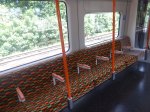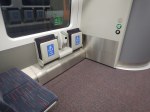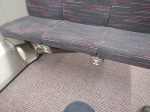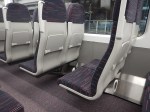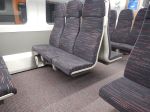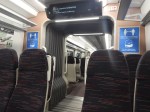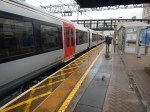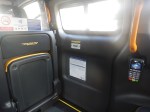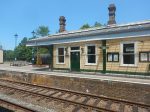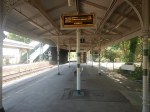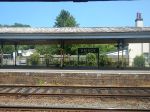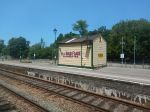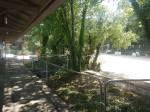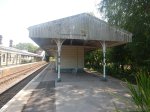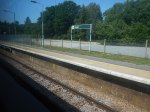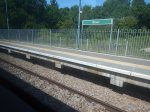Rail Baltica Concept Trains Inspired By Sun, Sea And Sand
The title of this post, is the same as that of this article on Railway Gazette.
The article shows concept images and I suspect that any of Europe’s train makers could make trains like these.
Rail Baltica will have following route and specification.
- It will eventually run between Helsinki and Warsaw, via Estonia, Latvia and Lithuania.
- There will be a tunnel between Helsinki and Tallinn.
- It will carry both passengers and freight.
- Freight trains will have a maximum length of 1050 metres, as opposed to 775 metres in the UK.
- It will be mainly double-track.
- It will be a standard gauge track with right-hand running, as all countries in the area use right-hand running.
- There will be no level crossings.
- It will have 25 KVAC overhead electrification.
- There will be ERTMS signalling.
- Passenger trains will run at 249 kph (161 mph)
- It is intended to be completed in mid-2026
The specification is similar to High Speed Two, with these exceptions.
- High Speed Two is faster at 205 mph.
- High Speed Two runs on the left.
- High Speed Two will not carry freight.
Phases 1 and 2a of High Speed Two should complete in 2029-2033, with Phase 2b following in 2035.
The bidders to build High Speed Two’s rolling stock include.
- Alstom Transport
- Bombardier Transportation (acquired by Alstom Transport on 29 January 2021) and Hitachi Rail Europe consortium
- Construcciones y Auxiliar de Ferrocarriles
- Patentes Talgo
- Siemens Mobility
I wouldn’t be surprised to see a similar list of companies tendering to build the trains for Rail Baltica.
- Stadler, who have factories in Poland may be added to the list.
- As the trains are being designed at the same time as High Speed Two trains, I wouldn’t be surprised to be similarities.
- They would also have to be designed for both left and right hand running, if there was any chance of a service between Paris and Helsinki.
- Although, they will run under 25 KVAC electrification on Rail Baltica,they may need to be able to run on other voltages.
I very much feel that Rail Baltica will be offered a selection of excellent trains.
Where Will The Trains Be Built?
Consider
- This obviously depends, where winning bidder has factories.
- But there is also the problem of getting trains between the factory and the Baltic.
- This could be difficult for factories in Spain, as there would need to be a gauge change.
- It would be easier, if the route were standard gauge all the way, as it would be from France, Germany, Italy and the UK
- If a Spanish company got the contract, could it build the trains in the UK, as delivery could be easier.
- I puzzle, why Talgo are building a factory in Scotland without any UK orders. But it would be easier to deliver trains to Russia and Eastern Europe by sea from Longannet than Spain.
There are a lot of factors that will define where the trains will be built.
Air-Conditioned Piccadilly Line Train Designs Presented
The title of this post, is the same as that of this article on Railway Gazette.
The article has four pictures of the final design of the new trains for the Piccadilly Line and the pictures don’t seem to be the same as those I took of the mock-up in October 2013 and can be seen in Siemens’ View Of The Future Of The Underground.
- The design has a less dramatic nose compared to the mock-up.
- It also appears to be taller.
- Judging by the external profile, the design has a clerestory to perhaps add a couple of inches.
- The seats appear to have a chunky profile. Is the air-conditioning partly behind the seats.
The interior seems to borrow heavily on the design for the London Overground’s Class 710 train.
Note.
- The air-conditioning outlets in front of or underneath the seats.
- No grilles behind the seats.
- The Class 710 train has a clerestory for extra height, but it is not visible on the outside. Does the one on the Siemens’ design have grilles from air entry or exit?
These are some views of seats in current Underground stock.
Note.
- The Piccadilly Line trains were fully refurbished in 2001.
- The Northern Line trains were fully refurbished in 2013.
- The grilles behind the seats on the Northern Line trains.
You can see a progression through the various designs, with the Class 710 trains
It looks like Siemens are using a similar interior layout to current trains on the Underground and the Overground.
A few thoughts.
Heated Floors
Some Bombardier Aventras like Greater Anglia’s Class 720 trains have heated floors. Will Siemens copy this idea?
These trains will go to some of the coldest parts of the Underground around Cockfosters.
USB Charging
This Siemens’ picture shows a front view of the seats.
I thought for a moment, that there was a USB charge point in the front of the seat, but on second thoughts, that is just a fitting to enable extra vertical grab rails.
Siemens should put USB charge points in the arm rests, as Vivarail have done.
Good design is often simple.
Walk-Through Cars
The Railway Gazette article says this about walk-through cars.
The longer cars and walk-through interior of the articulated design would maximise the usable interior space, increasing capacity by 10%.
They say nothing about what I think is there biggest advantage – Passengers can freely circulate in the train, to perhaps get a better seat or be better placed for a quick exit.
Do women feel less vulnerable in wall-through trains?
Step-Free Entry
One of the good points of the mock-up in 2013 was that entrance into the train was step-free, as this picture shows.
But look at this screen-capture for the detailed design.
The doors now seem a couple of inches above the platform.
Have the designers removed a must-have feature?
German trains have a terrible reputation for not being step-free between train and platform, but if Stadler and Merseyrail can do it with the new Class 777 trains, then surely it can be done on the London Underground.
Front End
The previous two pictures do show the front end of the mock-up and final design well.
I do wonder, if the original design with the bar across didn’t go down to well with drivers.
- The driver on most trains sits to the left.
- Trains in the UK generally run on the left.
- Signals on the Underground are usually placed on the left.
So did the bar across get in the way of looking across at passengers, as a train entered a station?
Driver’s Doors
The previous two pictures also show that the original mock-up is without a door for the driver, but that these have been added to the final design.
Perhaps drivers feel a separate door is necessary, as it can’t be blocked by baggage, bicycles or buggies.
Train Length
In Thoughts On The New Tube For London, I speculated about train length and feel that with clever cab design, that the trains can be a bit longer than the platform with the walk-through design.
After all on the East London Line at a few stations, the platforms aren’t long enough for the five-car trains and passengers in the last car are just asked to walk forward.
This picture shows what happens on the Overground at Canada Water station.
Those travelling in the last car of the train have to walk forward to the front doors of the car to exit. I suspect that with Siemens new trains, this will be the case on the Piccadilly Line.
The big advantage is that it avoids lengthening the platforms, which would be extremely tricky and very expensive.
So will the new Siemens trains be made longer, by allowing overhang into the tunnel at the rear and messaging to inform passengers?
I think they might!
Wikipedia gives the length of the new Siemens 2024 Stock as 113.7 metres, which compares with the 106.8 metres of the current 1973 Stock.
So the new trains are 6.9 metres longer.
Does that mean that if the front of the train is at the same position it is now, the rear end of the train will be overhanging the platform, by almost seven metres?
Judging by what happens on the East London Line, I think it would be feasible. It could even be a few metres longer, in which case the first set of double-doors would be outside the platform and wouldn’t open.
Seats Per Car
I believe this Siemens’ picture shows the view of one of the end cars looking towards the driver’s cab.
Note.
- The red and green labels on the door to the driver’s compartment at the far end.
- The two pairs of passenger doors and the lobbies with the black floors.
- The six banks of seats, each of which have six individual seats.
This means that the driver cars each have thirty-six seats.
According to Wikipedia, each new Siemens train has nine cars and a total of 268 seats.
So that means that the middle seven cars have a total of 196 seats or twenty-eight in each car. What convenient numbers!
Could that mean that the seven intermediate cars have four banks of seven seats arranged around a lobby with a pair of double-doors on both sides?
Could the intermediate cars have just one set of wide doors? I shall be taking a tape measure and my camera to a Class 710 train, to see what Bombardier have done.
So a new Siemens train might look something like this.
- Car 1 – driver cab – six seats – double-door/lobby – six seats – double-door/lobby – six seats
- Car 2 – seven seats – double-door/lobby – seven seats
- Car 3 – seven seats – double-door/lobby – seven seats
- Car 4 – seven seats – double-door/lobby – seven seats
- Car 5 – seven seats – double-door/lobby – seven seats
- Car 6 – seven seats – double-door/lobby – seven seats
- Car 7 – seven seats – double-door/lobby – seven seats
- Car 8 – seven seats – double-door/lobby – seven seats
- Car 9 – six seats – double-door/lobby – six seats – double-door/lobby – six seats- driver cab
Note.
- There will be a maximum of fourteen seats between any two entrance and exit lobbies.
- The train will have eleven sets of doors on either side.
- Trains of different lengths can be made for the Waterloo and City Line, where trains are shorter, and the Jubilee, where trains are longer, by just removing or adding intermediate cars.
For the Piccadilly Line, so long as the distance between the front of the train and the first set of doors is greater than 6.9 metres, these trains can be run using the overhanging into the tunnel method used on the East London Line of the London Overground.
Observations From The Underground And Overground
I went for a look and can say this.
- The seats on Overground Class 710 trains and Underground S Stock trains have a width of 0.5 metres. So is this a Transport for London standard?
- Double doors on both trains are around 1.5 metres wide.
On Class 710 trains, some cars have a run of fourteen seats. Is it a design clue for Transport for London train interiors?
There must be some proof somewhere that fourteen 0.5 metre seats and two 1.5 metre lobbies can handle large numbers of passengers.
The new Siemens trains will have an articulated join in the middle.
Could The Trains Be Lengthened?
The only things we know about the lengths of the cars of the new Siemens trains are.
- The average length of cars is 12.6 metres.
- The two driving cars are probably identical.
- The seven intermediate cars are probably identical.
- The distance between the end of the train and the first set of doors must be long enough to allow the first set of doors to open on the platform, with nearly seven metres of the train in the tunnel.
If we assume that the length of the intermediate car is X metres and it has two banks of seats and one lobby, then the driving car with three banks of seats, two lobbies and a driving cab could be almost twice as long.
I can do a little calculation.
How long would the driver cars be for various lengths of intermediate car?
As the driver car is effectively an intermediate car with an extra pair of doors/lobbie and an overhang containing another set of sets and the driving cab, I can also estimate the between the end of the train and the first set of doors, by subtracting the intermediate car length and two metres for the lobby from the driver car length
- 9 metres – 25.35 metres – 14.35 metres
- 9.5 metres – 23.6 metres – 12.1 metres
- 10 metres – 21.85 metres – 9.85 metres
- 10.5 metres – 20.1 metres – 7.6 metres
- 11 metres – 18.35 metres – 5.35 metres
- 12 metres – 14.85 metres – 0.85 metres
Note.
- The three figures are intermediate car length, driver car length and an estimate of the distance between the end of the train and the first set of doors.
- I shall improve this table, when I get the measurements from a Class 710 train.
- As there is a need for at least an overhang into the tunnel of at least 6.9 metres, it looks like intermediate cars can’t be longer than 10.5 metres.
Suppose that the intermediate car length is 10.5 metres.
Adding an extra car would mean that the new train length would be 124.2 metres, which would be 17.4 metres longer than the current Piccadilly Line 1973 Stock train.
This would be an overhang of 8.7 metres at both ends of the train, which would probably mean that the train wouldn’t fit the route, as the overhang is not long enough to accommodate it.
But with a length of ten metres, the overhang would be only 8.45 metres, which would appear to be feasible.
I wonder, if it would be possible with appropropriate modifications to the tunnel mouths and by using in-cab signalling to run ten car trains, if the intermediate cars were limited to ten metres.
- It looks to be possible mathematically.
- There would need to be no modifications to the platforms.
- There would be a ten percent increase in capacity.
It will hopefully come clear, when Siemens release the length of the driver and intermediate cars.
I believe that it is possible, that Siemens have designed these trains, so they can be extended without having to lengthen the platforms.
My First Ride In A Class 720 Train
Today, I took my first ride in one of Greater Anglia‘s Class 720 train.
It was only between Liverpool Street and Stratford.
Notes and questions.
- Are all of the individual seats identical and can they be arranged as ones, twos or threes as required?
- Could this mean, that Greater Anglia could create a 2 + 2 version with tables. if they felt such a train was necessary for some routes?
- The details like luggage racks, wheelchair spaces and power sockets seem to be of a high standard.
- The ride seemed smooth. But if I was going between Liverpool Street and Norwich, I’d prefer to ride in one of Greater Anglia’s Stadler trains.
- The last picture is of the seats in a Class 345 train, as I wanted to judge a comparison.
- The Class 720 seat appears to my posterior to be slightly more comfortable, than the Class 345 seat.
This train is more than just a high-capacity suburban trundler.
Jaguar Car Brand To Be All-Electric By 2025
The title of this post, is the same as that of this article on the BBC.
It would appear, that some of the larger vehicles will be powered by hydrogen.
But it is an interesting, even if it is an inevitable move.
I find these two paragraphs interesting.
But it has dropped plans to build an electric version of its XJ saloon at the Castle Bromwich plant, meaning the site will eventually stop making cars.
Chief executive Thierry Bolloré said the plant would focus instead on “non-production” activities in the long term, without giving details.
Note.
- Castle Bromwich is a large site.
- It’s probably not in the best place to build thousands of cars.
- Would turning it into a giant battery-pack factory be classed as non-production?
It sounds like there’s a cunning plan.
- As an engineer, I believe, there’s only one way to build an electric car and that is as light in weight as possible to make sure the car goes as far as possible on each charge of the battery.
- So this will mean the sort of construction methods used for Formula One cars and aircraft.
- Will this in turn mean a brand new factory, that makes cars in radically different ways?
I think there’s a lot more to be disclosed.
All I wanted For Christmas Was A Short-Sleeved Dressing Gown
If it is one thing that annoys me, is a dressing gown, with long voluminous sleeves.
So I asked my son and son-in-law to get me one with short sleeves.
I have worn it to do the washing up and I’m wearing it, whilst writing this post.
A Ride In A Dynamo Electric Taxi
I came out of Marks and Spencer on Finsbury Pavement and an unusual black taxi was sitting on the rank opposite.
So I had to take a ride.
It was a Dynamo Electric Taxi based on a Nissan e-NV200 Evalia MPV.
These are my thoughts.
The Two Major Complaints About The LEVC TX Cab From Drivers
There are two major complaints about the LEVC TX from drivers.
- It is too expensive to buy.
- The range on battery power is not far enough.
I’ve also had several conversations about hydrogen power
My Taxi Use
As I have a Freedom Pass, I only travel in taxis about twice a month. Usually this is when I’m coming home from a railway station like Euston, Liverpool Street or Kings Cross in the evening and I want to get home quickly, or I am coming home with shopping, as I was today. Only occasionally, do I use a taxi with somebody else.
I’d be interested to know, the average number of passengers in a black cab.
Dynamo Has Developed A Vehicle To Sell
I feel that Dynamo have developed a vehicle that will sell.
- The driver said that it is £20,000 cheaper than the LEVC TX.
- The web site says that the battery range is at least twice that of the LEVC TX.
- The capacity is one less than the lEVC TX, which is probably not a large disadvantage.
- The cab includes four different charging methods.
- It can even be charged from a 13-amp socket.
- It can carry one person in a wheelchair.
- Roomy enough for taller drivers.
- Dynamo claimed to have talked to the drivers. As they have addressed, their two major complaints, that seems about right.
- It has a glass roof, as does the LEV TX, which is a good feature for a cab,
- It is 100 % electric and zero carbon.
Overall, it seems to have been designed to have a low cost of ownership. Being based on a standard vehicle must help.
Would It Appeal To Drivers In Smaller Towns And Cities?
After my stroke, I used a lot of taxis to go between my house and the local bus station in Haverhill, which was a distance of about four miles.
Haverhill is a town of 27,000 people without a railway station.
- The nearest railway station at Dullingham is 10 miles away.
- Cambridge is 18 miles away.
- Bury St. Edmunds is 19 miles away.
I feel that the range could be sufficient to run a taxi service in a town like Haverhill.
So could the Dynamo taxi, bring black cabs to more areas?
Ride Quality
Ride quality was what I would expect from a modern vehicle.
Comfort And Space
Comfort was very similar to that of an LEVC TX, but there was a little bit less space. But that wouldn’t bother me.
Would I Use One Again?
I can’t see any reason not to!
I might even choose one in preference to an LEVC TX or a Mercedes Vito, as my road can sometimes be congested and a smaller vehicle might be an advantage.
Conclusion
The Dynamo Black Cab looks to be a serious alternative to the LEVC TX. Especially, as the design has addressed the two major complaints of drovers; cost and range and the vehicle is 100 % electric.
In my lifetime, there have been alternative black cabs, like the Winchester, the Mercedes Vito and the Metrocab.
I can see others joining the market.
South Wales Metro Railway Works Imminent
The title of this post, is the same as that of this article on Rail Technology Magazine.
Work starts on the third of August and is described in this sentence,
TfW is now starting to build the South Wales Metro which will see major infrastructure works including the electrification of over 170km of track mostly with overhead lines, station and signalling upgrades and the construction of at least five new stations.
It will be one of the most innovative electrification projects ever performed in the UK, as it uses discontinuous electrification.
I explained discontinuous electrification in More On Discontinuous Electrification In South Wales, where I said this.
In the July 2018 Edition of Modern Railways, there is an article entitled KeolisAmey Wins Welsh Franchise.
This is said about the electrification on the South Wales Metro.
KeolisAmey has opted to use continuous overhead line equipment but discontinuous power on the Core Valley Lnes (CVL), meaning isolated OLE will be installed under bridges. On reaching a permanently earthed section, trains will automatically switch from 25 KVAC overhead to on-board battery supply, but the pantograph will remain in contact with the overhead cable, ready to collect power after the section. The company believes this method of reducing costly and disruptive engineering works could revive the business cases of cancelled electrification schemes. Hopes of having money left over for other schemes rest partly on this choice of technology.
Other points made include.
-
- A total of 172 km. of track will be electrified.
- The system is used elsewhere, but not in the UK.
- Disruptive engineering works will be avoided on fifty-five structures.
- Between Radyr and Ninian Park stations is also proposed for electrification.
Nothing is said about only electrifying the uphill track, which surely could be a way of reducing costs.
I wrote the last sentence, as surely coming down the hills, the trains can be powered by Newton’s friend.
The New Stations
This article on Business Live, gives the list of new stations and their completion dates.
- Crwys Road – End of 2022
- Loudoun Square – End of 2023
- Cardiff Bay – End of 2023
- Treforest Estate – End of 2025
- Gabalfa – 2028
If the builders crack on as they did at Horden station, I wouldn’t be surprised to see those dates achieved, with time to spare.
Eridge Station – 23rd June 2020
Eridge station is going to have a makeover, which starts this weekend.
So I went to have a look and took these pictures.
Note.
- The station certainly needs a new footbridge.
- The builders were clearing a work site to get access to the station.
- The station will be kept open throughout the work according to this article on Crowborough Life.
The station could end up as a good mix of ancient and modern.
Some Pictures Of Platform Edges On The Uckfield Branch
I took these pictures on my visit to Eridge station yesterday.
The platform edges are a very mixed bunch.
- Some are only a couple of years old and were built, as part of new platform extensions.
- Some were built using pre-fabricated components.
- Some are of fairly indeterminate age.
- The ones at Eridge station probably date from when the station was opened in 1868.
I would suspect that your patio is in better condition than some of these important interfaces between train and platform.
So why did I photograph them?
In First Of A Kind Funding Awarded For 25 Rail Innovation Projects, Project Number Number 4 from Sheffield Hallam University was entitled Illumin Heated Concrete Platform Coper Slabs and was described like this.
Illuminated and heated low-energy concrete slabs for station platforms, which automatically switch on in freezing conditions to help prevent passengers from slipping on ice.
Some more information was given in Heated Railway Platforms Tested To Avoid Ice Accidents.
Could these platforms be fitted to a set of platform edges like these?
I would hope so.
If so, new smoother platforms and not just the edges, would also hope to cut small falls.



